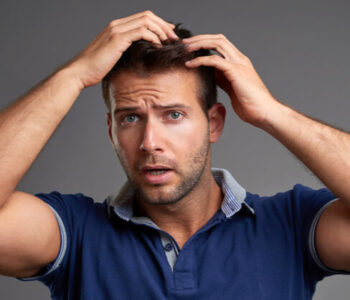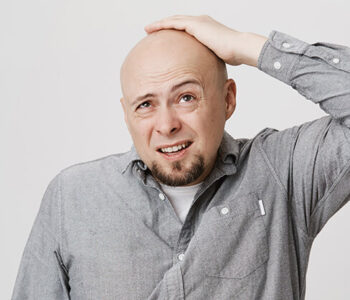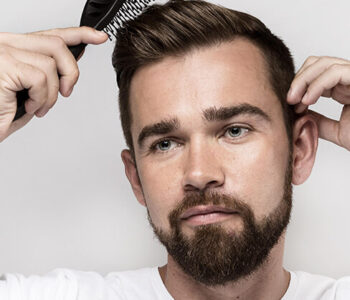In 30 seconds…
Rogaine (or Regaine in the UK) is an FDA-approved, over-the-counter treatment for hair loss. The active ingredient in Rogaine is Minoxidil, which widens the blood vessels in your scalp to encourage a healthier supply of oxygen and nutrients to the hair.
Treating Male Pattern Hair Loss
Male pattern baldness (MPB) is a condition that affects the vast majority of men. In fact, it’s estimated that, by the age of 50, 85% of us will have significant signs of thinning hair. For many, those signs come much sooner — and they can bring feelings of frustration, shame, and loss.
But it doesn’t have to be this way. These days, there are many treatment options available for men suffering from MPB (or androgenetic alopecia, as it’s technically known). These include surgical interventions, like hair transplants, and non-surgical hair replacements. There are also natural remedies, which many trust to promote hair regrowth (although the jury is still out on whether they actually work).
Here, though, we’re telling you all about Rogaine. It’s a topical hair loss spray or solution powered by one of the only treatments we know to be effective in treating balding and a receding hairline: Minoxidil.
Introducing Rogaine
Rogaine is one of the best-known treatments out there for male pattern baldness. It was the first over-the-counter medication to be developed for hair loss and it remains one of the most effective treatments available.
But let’s clear up some confusion. Rogaine is a US brand, manufactured by Johnson & Johnson. In the UK, the same product is sold by a different name: Regaine. Two names for the same product. The really important thing, though, is the active ingredient that powers both brands. That’s Minoxidil.
Minoxidil is a medicine known as a vasodilator. When applied to the scalp, Minoxidil works to widen (or dilate) the blood vessels in the area, promoting healthy blood flow and encouraging the movement of nutrients and oxygen to your hair follicles. All this goodness is crucial for the health of your hair production. Because when your follicles get the support they need, they’re much better equipped to produce healthy hair.
That, in short, is the science of what Rogaine and Regaine do to produce new hair growth. It’s all thanks to Minoxidil. While that active ingredient will do the heavy lifting, you’ll just need to apply the topical solution or foam.
How Effective is Minoxidil?
You now know how it works. But how well does Minoxidil work? There’s a good reason why Rogaine has remained one of the favourite hair loss treatments around. That’s because it’s safe and effective.
According to the best-known study, Minoxidil is effective in over two-thirds of men who use it. And the stronger the better. Another study has shown that you’re likely to see 45% more hair growth by choosing the product that Rogaine and Regaine call ‘Extra Strength’, as opposed to the ‘Normal Strength’ product.
What you should know is that all hair loss treatments (not just Rogaine) are more effective the sooner you start. If you have areas on your scalp where no hair grows at all, you may struggle to promote hair regrowth. Why? Because if MPB progresses too far, the follicles in those areas may have died.
For the most effective solution to hair loss, start treatment early.
Combining Rogaine and Finasteride
A way to boost the effectiveness of Minoxidil is to combine it with another hair loss treatment called Finasteride.
While Minoxidil tackles the health of your follicles on your scalp, Finasteride intervenes in the process that causes MPB in the first place. Male hair loss is caused by a hormone known as dihydrotestosterone, or DHT, which causes your hair follicles to weaken and shrink in a process called follicle miniaturisation. Finasteride lowers the production of DHT, reducing long-term damage to your follicles.
That’s why many men battling hair loss take both Finasteride and Minoxidil together. In one study, 94% of men who used both treatments experienced improved hair coverage. In another, the Finasteride and Minoxidil combo increased visible results by a third.
Rogaine Treatment: Things to Be Aware Of
Rogaine is sold as a topical foam, a spray, or a solution. Most men prefer the spray, as it’s easier to apply, stops your hands from getting dirty, and takes the hassle out of the application process. This is important because how well you apply the solution affects the results — and the likelihood of side effects.
Talking of side effects, here are some crucial things you should know when using Rogaine.
Side Effects?
Every medical product has possible side effects. Before taking any treatments, it’s worth being clear on the risks.
Side effects of Minoxidil can include:
- Scalp irritation (usually the result of the cetyl alcohol in the solution)
- Dizziness, drowsiness, light-headedness, or headaches
- Swelling on the face, head, or hands
- Weight gain
- Changes in the length or thickness of facial or body hair (This one is usually the result of misapplication, as the product can end up in areas where it shouldn’t be).
- Chest pain
While they sound a little scary, studies have found that the side effects of Rogaine are uncommon. The drug has been approved by the FDA (that’s the US Food and Drug Administration) and Regaine by the UK’s NHS for use in the treatment of hair loss. So you can trust that it’s safe and effective.
Read our article on the side effects of Minoxidil for more information.
Who Shouldn’t Use Minoxidil?
Some people are recommended to seek medical advice before taking Rogaine or Minoxidil. These include:
- People with uncontrolled blood pressure
- Men with unstable heart disease
- People experiencing hair loss for reasons other than male pattern baldness. If your hair loss is accompanied by scabs, lesions, or irritation, don’t use Rogaine. The active ingredient is more likely to enter your bloodstream and cause unwanted side effects.
If in doubt, talk to us. We can help you decide whether Rogaine is the right hair loss treatment for you.
Key Takeaways
Rogaine is a topical treatment for male pattern baldness. Powered by Minoxidil, it’s safe, effective, and has been proven to stop balding with dedicated use.
For the best results, though, combine Rogaine with Finasteride. With combined treatment, 95% of men in studies have seen hair regrowth.
FAQs
What’s the difference between Rogaine and Regaine?
Rogaine and Regaine are two names for the same thing, there is no difference between them. Rogaine is an American product produced by Johnson & Johnson, whilst Regaine is the name that product is sold under in the UK.
How does Rogaine work?
Rogaine’s active ingredient is Minoxidil, a vasodilator, which dilates the scalp’s blood vessels to promote a healthier supply of oxygen and nutrients to the hair.
How effective is Rogaine?
Rogaine is one of the most effective over-the-counter hair loss treatments available. Around two thirds of men who use a Minoxidil-based product like Rogaine see improvements in hair regrowth.
Is Rogaine safe to use?
Yes, Rogaine is FDA-approved and safe to use. You should only consider not using Rogaine or other Minoxidil products if you have uncontrollable blood pressure, heart disease, or are suffering hair loss for any reason other than MPB (Male Pattern Baldness). If your hair loss is accompanied by scabs, lesions, or irritation, don’t use Rogaine.












